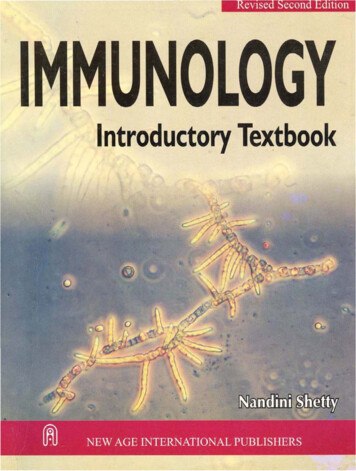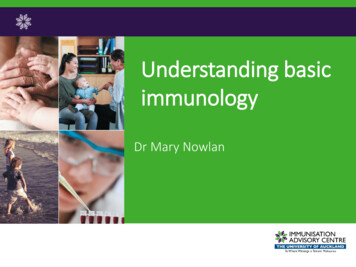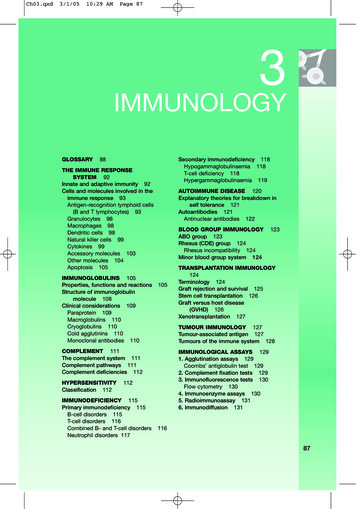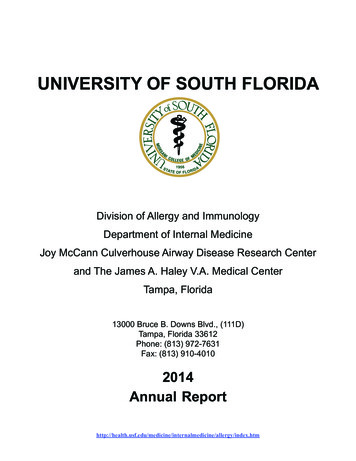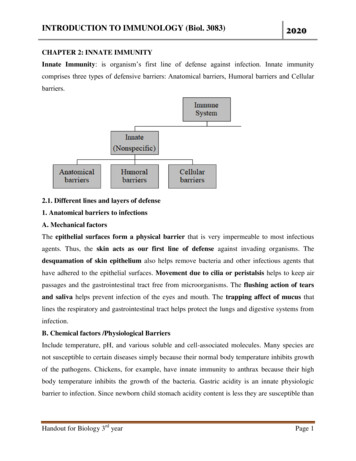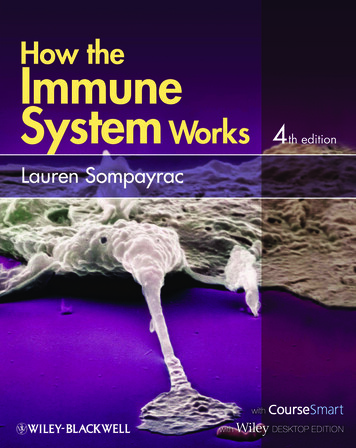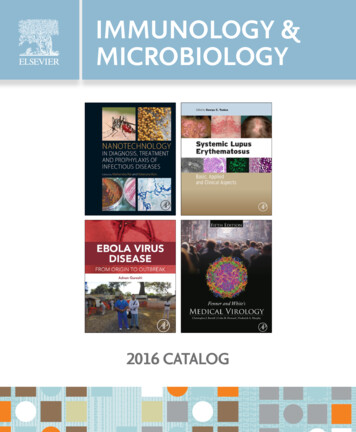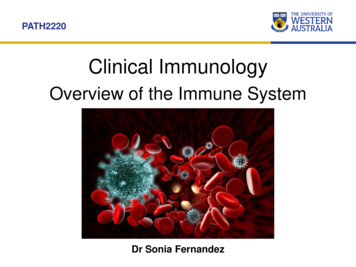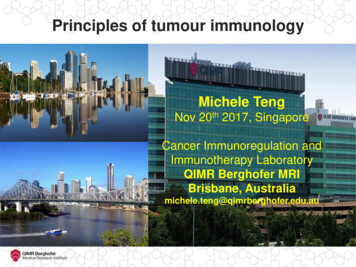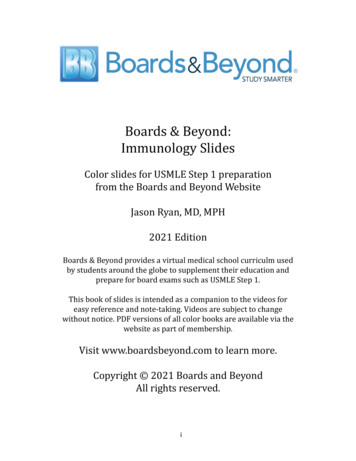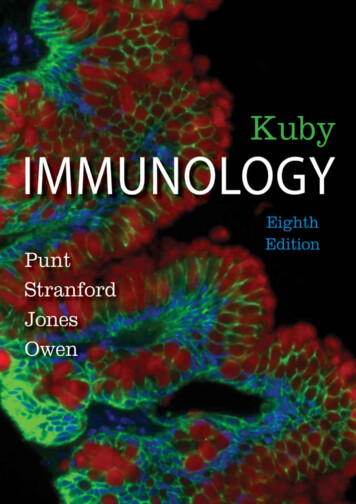
Transcription
2
Kuby IMMUNOLOGY3
4
Kuby IMMUNOLOGYEighth EditionJenni PuntUniversity of PennsylvaniaSharon A. StranfordPomona CollegePatricia P. JonesStanford UniversityJudith A. OwenHaverford College5
Vice President, STEM: Daryl FoxExecutive Editor: Lauren SchultzExecutive Marketing Manager: Will MooreMarketing Assistant: Savannah DiMarcoDevelopment Editor: Erica ChampionDevelopment Editor: Erica Pantages FrostMedia Editor: Jennifer ComptonAssistant Editor: Kevin DavidsonSenior Content Project Manager: Liz GellerSenior Media Project Manager: Jodi IsmanPermissions Manager: Jennifer MacMillanPhoto Researcher: Richard FoxDirector of Design, Content Management: Diana BlumeDesigner: Blake LoganIllustrations: ImagineeringIllustration Coordinator: Janice DonnolaSenior Workflow Project Supervisor: Susan WeinProduction Supervisor: Lawrence GuerraComposition: Lumina Datamatics, Inc.Printing and Binding: LSC Communications, Inc.North American EditionCover Image: Courtesy of Audra Devoto and Xian-McKeon LaboratoryLibrary of Congress Control Number: 2018939693ISBN-13 [mobi]:978-1-319-26722-3 2019, 2013, 2007, 2003 by W. H. Freeman and CompanyAll rights reservedPrinted in the United States of AmericaFirst printingNorth American EditionW. H. Freeman and CompanyOne New York PlazaSuite 4500New York, NY 10004-1562www.macmillanlearning.com6
7
To all the students, fellows, and colleagues who have made our careers in immunology a source ofjoy and excitement, and to our families and mentors who made these careers possible. We hopethat future generations of immunology students will find this subject as fascinating and rewardingas we have. And in memory of Shannon Moloney, who had too little time to finish her own lifegoals but who will be remembered for how she helped us to meet our goals in this project.8
About the AuthorsAll four authors are active scholars and teachers who have been/are recipients of research grantsfrom the NIH and the NSF. They have all served in various capacities as grant proposal reviewersfor the NSF, NIH, HHMI, and other funding bodies and, as well, have evaluated manuscriptssubmitted for publication in immunological journals. In addition, they are all active members ofthe American Association of Immunologists (AAI) and have served that national organization in avariety of ways.Jenni Punt received her A.B. from Bryn Mawr College, magna cum laude, with high honors inbiology from Haverford College. She was a combined degree student at the University ofPennsylvania, graduating summa cum laude from the School of Veterinary Medicine (V.M.D.) witha Ph.D. in immunology. She pursued her interest in T-cell development as a Damon RunyonWalter Winchell Physician-Scientist fellow with Dr. Alfred Singer at the National Institutes ofHealth and was appointed to the faculty of Haverford College in 1996. After 18 wonderful yearsthere, working on T-cell and hematopoietic stem cell development, she accepted a position asassociate dean for student research at Columbia University’s College of Physicians and Surgeons.There she was the founding director of an M.D./M.Sc. dual degree program and co-ran a laboratoryon hematopoiesis with her husband, Dr. Stephen Emerson. After being tempted back to the Schoolof Veterinary Medicine at the University of Pennsylvania, she is now developing new educationalprograms as director of One Health Research Education. She has received multiple teachingawards over the course of her career and continues to find that students are her most inspirationalcolleagues.9
Sharon Stranford received her Ph.D. in microbiology and immunology from HahnemannUniversity (now Drexel), where she studied multiple sclerosis. She then spent 3 years exploringtransplant immunology as a postdoctoral fellow at Oxford University, followed by 3 years at theUniversity of California, San Francisco, conducting human HIV/AIDS research. In 2001 she washired as a Clare Boothe Luce Assistant Professor at Mount Holyoke College, a small liberal artscollege for women in Massachusetts, where she served in the Department of Biological Sciencesand the Program in Biochemistry for 12 years. Sharon is now a professor of biology at PomonaCollege in Claremont, California, where she investigates immunologic markers that influencesusceptibility to immune deficiency. She also studies the science of teaching and learning; inparticular, initiatives within STEM that foster a sense of inclusion and that welcome firstgeneration college students, like herself. Her teaching repertoire, past and present, includes cellbiology, immunology, advanced laboratories in immunology, and seminars in infectious disease,as well as a team-taught course blending ethics and biology, entitled “Controversies in PublicHealth.”10
Pat Jones graduated from Oberlin College in Ohio with highest honors in biology and obtained herPh.D. in biology with distinction from Johns Hopkins University. She was a postdoctoral fellow ofthe Arthritis Foundation for 2 years in the Department of Biochemistry and Biophysics at theUniversity of California, San Francisco, Medical School, followed by 2 years as an NSF postdoctoralfellow in the Departments of Genetics and Medicine/Immunology at Stanford University School ofMedicine. In 1978 she was appointed assistant professor of biology at Stanford and is now a fullprofessor and currently holds the Dr. Nancy Chang Professorship in Humanities and Sciences. Pathas received several undergraduate teaching awards, was the founding director of the Ph.D.Program in Immunology, served as vice provost for faculty development and diversity, and in July2011, she assumed the position of Director of Stanford Immunology, a position that coordinatesimmunology training activities across the university.Judy Owen holds B.A. and M.A. (Hons) degrees in biochemistry from Cambridge University. Shepursued her Ph.D. at the University of Pennsylvania with the late Dr. Norman Klinman and herpostdoctoral fellowship with Dr. Peter Doherty in viral immunology. In 1981, she was appointed tothe faculty of Haverford College, one of the first undergraduate colleges to offer a course inimmunology. Judy teaches numerous laboratory and lecture courses in biochemistry andimmunology; her teaching awards include the Excellence in Mentoring Award from the AmericanAssociation of Immunologists. She is currently a participant in Haverford’s First Year WritingProgram and has been involved in curriculum development across the college. Judy served asdirector of the Marian E. Koshland Integrated Natural Sciences Center from 2013 to 2017 andcurrently holds the Elizabeth Ufford Green Professorship in Natural Sciences.Together, Jenni Punt and Judy Owen developed and ran the first AAI introductory immunologycourse, which is now offered on an annual basis.11
Brief ContentsI. IntroductionChapter 1: Overview of the Immune SystemChapter 2: Cells, Organs, and Microenvironments of the Immune SystemChapter 3: Recognition and ResponseII. Innate ImmunityChapter 4: Innate ImmunityChapter 5: The Complement SystemIII. Adaptive Immunity: Antigen Receptors and MHCChapter 6: The Organization and Expression of Lymphocyte Receptor GenesChapter 7: The Major Histocompatibility Complex and Antigen PresentationIV. Adaptive Immunity: DevelopmentChapter 8: T-Cell DevelopmentChapter 9: B-Cell DevelopmentV. Adaptive Immunity: Effector ResponsesChapter 10: T-Cell Activation, Helper Subset Differentiation, and MemoryChapter 11: B-Cell Activation, Differentiation, and Memory GenerationChapter 12: Effector Responses: Antibody- and Cell-Mediated ImmunityChapter 13: Barrier Immunity: The Immunology of Mucosa and SkinChapter 14: The Adaptive Immune Response in Space and TimeVI. The Immune System in Health and DiseaseChapter 15: Allergy, Hypersensitivities, and Chronic InflammationChapter 16: Tolerance, Autoimmunity, and TransplantationChapter 17: Infectious Diseases and VaccinesChapter 18: Immunodeficiency DiseasesChapter 19: Cancer and the Immune SystemVII. Experimental MethodsChapter 20: Experimental Systems and MethodsAppendix I: CD AntigensAppendix II: Cytokines and Associated JAK-STAT Signaling MoleculesAppendix III: Chemokines and Chemokine ReceptorsGlossaryAnswers to Study QuestionsIndex12
13
Feature Boxes in Kuby Immunology, Eighth Edition14
CLINICAL FOCUSBox 1-1 Vaccine Controversy: Weighing Evidence against Myth and Personal Freedom againstPublic GoodBox 1-2 Passive Antibodies and the IditarodBox 1-3 The Hygiene HypothesisBox 2-2 Stem Cells—Clinical Uses and PotentialBox 3-3 Cytokine-Based TherapiesBox 3-4 Defects in the B-Cell Signaling Protein Btk Lead to X-Linked AgammaglobulinemiaBox 4-3 Mutations in Components of Innate and Inflammatory Responses Associated with DiseaseBox 5-3 The Complement System as a Therapeutic TargetBox 6-2 Some Immunodeficiencies Result from Impaired Receptor Gene RecombinationBox 7-2 MHC Alleles and Susceptibility to Certain DiseasesBox 7-3 Without MHC, Cancer Can Be Devilishly Hard to SeeBox 8-2 How Do T Cells That Cause Type 1 Diabetes Escape Negative Selection?Box 9-3 B-Cell Development and Function in the Aging IndividualBox 10-2 Checkpoint Inhibitors: Breakthrough in Cancer TherapyBox 10-3 What a Disease Revealed about the Physiological Role of TH17 CellsBox 12-1 Therapeutic Antibodies for the Treatment of DiseasesBox 13-2 The Gut-Brain AxisBox 15-3 Type 2 Diabetes, Obesity, and InflammationBox 16-1 It Takes Guts to Be TolerantBox 16-2 Why Are Women More Susceptible Than Men to Autoimmunity? Sex Differences inAutoimmune DiseaseBox 16-3 Xenotransplantation: Science Fiction Turned FactBox 17-1 The Emerging Story of Zika VirusBox 17-2 Lessons Learned from Tuberculosis: Importance of TH1-type Responses in FightingIntracellular Bacterial InfectionsBox 17-3 Influenza Has Been Responsible for Some of the Worst Pandemics in History15
Box 17-4 African Sleeping Sickness: Novel Immune Evasion Strategies Employed by TrypanosomesBox 17-5 Schistosomiasis: Low Antigenicity and Large Size Pose Unique Challenges to ImmuneDetection and Elimination of HelminthsBox 18-1 Prevention of Mother-to-Child Transmission of HIVBox 19-1 A Vaccine to Prevent Cervical Cancer, and MoreBox 19-2 CAR T Cells: The Race for a Cancer Cure16
EVOLUTIONBox 2-4 Variations on Anatomical ThemesBox 4-4 Plant Innate Immune ResponsesBox 6-3 A Central Mechanism of the Adaptive Immune System Has a Surprising EvolutionaryOriginBox 7-1 The Sweet Smell of Diversity17
CLASSIC EXPERIMENTBox 2-1 Isolating Hematopoietic Stem CellsBox 2-3 The Discovery of a Thymus—and TwoBox 3-1 The Elucidation of Antibody StructureBox 3-2 The Discovery of the αβ T-Cell ReceptorBox 4-1 Discovery of Invertebrate Toll and Vertebrate Toll-like ReceptorsBox 5-1 The Discovery of Properdin (Factor P)Box 6-1 DNA Recombination of Immunoglobulin Genes Occurs in Somatic CellsBox 7-4 Demonstration of Self-MHC RestrictionBox 8-1 Insights about Thymic Selection from the First TCR Transgenic Mouse Have Stood the Testof TimeBox 9-2 The Stages of B-Cell Development: Characterization of the Hardy FractionsBox 10-1 Discovery of the First Costimulatory Receptor: CD28Box 12-3 Rethinking Immunological Memory: NK Cells Join B and T Lymphocytes as MemoryCapable CellsBox 15-1 The Discovery and Identification of IgE as the Carrier of Allergic HypersensitivityBox 16-4 Early Life Exposure to Antigens Favors Tolerance Induction18
ADVANCESBox 4-2 InflammasomesBox 5-2 Complement and the Visual SystemBox 9-1 Roles of Epigenetic Changes in the Control of B-Cell DevelopmentBox 10-4 Tolerance for Two: Jumping Genes, TREGs, and the Evolution of Immune Toleranceduring PregnancyBox 11-1 How Did Scientists Track the Movements of B Cells between the Dark and Light Zones ofthe Germinal Center?Box 12-2 Detection of Antigen-Specific T CellsBox 13-1 Cells Involved in Barrier ImmunityBox 13-3 Germ-Free Animal Model SystemsBox 14-1 Molecular Regulation of Cell Migration between and within TissuesBox 15-2 The Genetics of Asthma and AllergyBox 17-6 A Prime-and-Pull Vaccine Strategy for Preventing Sexually Transmitted DiseasesBox 18-2 Broadly Neutralizing Antibodies to HIVBox 20-1 Dynamic Imaging Techniques, or How to Watch a MovieBox 20-2 Optical Components of the Flow Cytometer19
ContentsChapter 1: Overview of the Immune SystemA Historical Perspective of ImmunologyEarly Vaccination Studies Led the Way to ImmunologyVaccination Is an Ongoing, Worldwide EnterpriseImmunology Is about More than Just Vaccines and Infectious DiseaseImmunity Involves Both Humoral and Cellular ComponentsHow Are Foreign Substances Recognized by the Immune System?Important Concepts for Understanding the Mammalian Immune ResponsePathogens Come in Many Forms and Must First Breach Natural BarriersThe Immune Response Quickly Becomes Tailored to Suit the AssaultPathogen Recognition Molecules Can Be Encoded as Genes or Generated by DNARearrangementTolerance Ensures That the Immune System Avoids Destroying the HostThe Immune Response Is Composed of Two Interconnected Arms: Innate Immunityand Adaptive ImmunityImmune Cells and Molecules Can Be Found in Many PlacesAdaptive Immune Responses Typically Generate MemoryThe Good, Bad, and Ugly of the Immune SystemInappropriate or Dysfunctional Immune Responses Can Result in a Range of DisordersThe Immune Response Renders Tissue Transplantation ChallengingCancer Presents a Unique Challenge to the Immune ResponseConclusionReferencesStudy QuestionsChapter 2: Cells, Organs, and Microenvironments of the Immune SystemHematopoiesis and Cells of the Immune SystemHematopoietic Stem Cells Differentiate into All Red and White Blood CellsHSCs Differentiate into Myeloid and Lymphoid Blood Cell LineagesCells of the Myeloid Lineage Are the First Responders to InfectionCells of the Lymphoid Lineage Regulate the Adaptive Immune ResponsePrimary Lymphoid Organs: Where Immune Cells DevelopThe Site of Hematopoiesis Changes during Embryonic DevelopmentThe Bone Marrow Is the Main Site of Hematopoiesis in the AdultThe Thymus Is the Primary Lymphoid Organ Where T Cells MatureSecondary Lymphoid Organs: Where the Immune Response Is Initiated20
Secondary Lymphoid Organs Are Distributed throughout the Body and Share SomeAnatomical FeaturesBlood and Lymphatics Connect Lymphoid Organs and Infected TissueThe Lymph Node Is a Highly Specialized Secondary Lymphoid OrganThe Spleen Organizes the Immune Response against Blood-Borne PathogensBarrier Organs Also Have Secondary Lymphoid TissueTertiary Lymphoid Tissues Also Organize and Maintain an Immune ResponseConclusionReferencesStudy QuestionsChapter 3: Recognition and ResponseGeneral Properties of Immune Receptor-Ligand InteractionsReceptor-Ligand Binding Occurs via Multiple Noncovalent BondsHow Do We Describe the Strength of Receptor-Ligand Interactions?Interactions between Receptors and Ligands Can Be MultivalentCombinatorial Expression of Protein Chains Can Increase Ligand-Binding DiversityAdaptive Immune Receptor Genes Undergo Rearrangement in Individual LymphocytesLevels of Receptor and Ligand Expression Can Vary during an Immune ResponseLocal Concentrations of Ligands May Be Extremely High during Cell-Cell InteractionsMany Immune Receptors Include Immunoglobulin DomainsImmune Antigen Receptors Can Be Transmembrane, Cytosolic, or SecretedImmune Antigen Receptor SystemsThe B-Cell Receptor Has the Same Antigen Specificity as Its Secreted AntibodiesT-Cell Antigen Receptors Recognize Antigen in the Context of MHC ProteinsReceptors of Innate Immunity Bind to Conserved Molecules on PathogensCytokines and Their ReceptorsCytokines Are Described by Their Functions and the Distances at Which They ActCytokines Exhibit the Attributes of Pleiotropy, Redundancy, Synergism, Antagonism,and Cascade InductionCytokines of the IL-1 Family Promote Proinflammatory SignalsClass 1 Cytokines Share a Common Structural Motif But Have Varied FunctionsClass 2 Cytokines Are Grouped into Three Families of InterferonsTNF Family Cytokines May Be Soluble or Membrane-BoundThe IL-17 Family of Cytokines and Receptors Is the Most Recently IdentifiedChemokines Induce the Directed Movement of LeukocytesA Conceptual Framework for Understanding Cell SignalingLigand Binding Can Induce Dimerization or Multimerization of Receptors21
Ligand Binding Can Induce Phosphorylation of Tyrosine Residues in Receptors orReceptor-Associated MoleculesSrc-Family Kinases Play Important Early Roles in the Activation of Many Immune CellsIntracellular Adapter Proteins Gather Members of Signaling PathwaysCommon Sequences of Downstream Effector Relays Pass the Signal to the NucleusNot All Ligand-Receptor Signals Result in Transcriptional AlterationsImmune Responses: The Outcomes of Immune System RecognitionChanges in Protein Expression Facilitate Migration of Leukocytes into Infected TissuesActivated Macrophages and Neutrophils May Clear Pathogens without InvokingAdaptive ImmunityAntigen Activation Optimizes Antigen Presentation by Dendritic CellsCytokine Secretion by Dendritic Cells and T Cells Can Direct the Subsequent ImmuneResponseAntigen Stimulation by T and B Cells Promotes Their Longer-Term SurvivalAntigen Binding by T Cells Induces Their Division and DifferentiationAntigen Binding by B Cells Induces Their Division and DifferentiationConclusionReferencesStudy QuestionsChapter 4: Innate ImmunityAnatomical Barriers to InfectionEpithelial Barriers Prevent Pathogen Entry into the Body’s InteriorAntimicrobial Proteins and Peptides Kill Would-Be InvadersCellular Innate Response Receptors and SignalingToll-Like Receptors Initiate Responses to Many Types of Molecules from ExtracellularPathogensC-Type Lectin Receptors Bind Carbohydrates on the Surfaces of ExtracellularPathogensNOD-Like Receptors Bind PAMPs from Cytosolic PathogensALRs Bind Cytosolic DNARLRs Bind Cytosolic Viral RNAcGAS and STING Are Activated by Cytosolic DNA and DinucleotidesInduced Innate Immunity Effector MechanismsExpression of Innate Immunity Proteins Is Induced by PRR SignalingPhagocytosis Is an Important Mechanism for Eliminating PathogensRegulated Cell Death Contributes to Pathogen EliminationLocal Inflammation Is Triggered by Innate Immune ResponsesInnate Lymphoid Cells22
Natural Killer Cells Are ILCs with Cytotoxic ActivityILC Populations Produce Distinct Cytokines and Have Different RolesRegulation and Evasion of Innate and Inflammatory ResponsesInnate and Inflammatory Responses Can Be HarmfulInnate and Inflammatory Responses Are Regulated Both Positively and NegativelyPathogens Have Evolved Mechanisms to Evade Innate and Inflammatory ResponsesInteractions between the Innate and Adaptive Immune SystemsThe Innate Immune System Activates Adaptive Immune ResponsesRecognition of Pathogens by Dendritic Cells Influences Helper T-Cell DifferentiationSome Antigens Containing PAMPs Can Activate B Cells Independent of Helper T CellsAdjuvants Activate Innate Immune Responses That Increase the Effectiveness ofImmunizationsSome Pathogen Clearance Mechanisms Are Common to Both Innate and AdaptiveImmune ResponsesUbiquity of Innate ImmunitySome Innate Immune System Components Occur across the Plant and AnimalKingdomsInvertebrate and Vertebrate Innate Immune Responses Show Both Similarities andDifferencesConclusionReferencesStudy QuestionsChapter 5: The Complement SystemThe Major Pathways of Complement ActivationThe Classical Pathway Is Initiated by Antibody Binding to AntigensThe Lectin Pathway Is Initiated When Soluble Proteins Recognize Microbial AntigensThe Alternative Pathway Is Initiated in Three Distinct WaysThe Three Complement Pathways Converge at the Formation of C5 Convertase andGeneration of the MACThe Diverse Functions of ComplementComplement Receptors Connect Complement-Tagged Pathogens to Effector CellsComplement Enhances Host Defense against InfectionComplement Acts at the Interface between Innate and Adaptive ImmunitiesComplement Aids in the Contraction Phase of the Immune ResponseThe Regulation of Complement ActivityComplement Activity Is Passively Regulated by Short Protein Half-Lives and Host CellSurface CompositionThe C1 Inhibitor, C1INH, Promotes Dissociation of C1 Components23
Decay-Accelerating Factor Promotes Decay of C3 ConvertasesFactor I Degrades C3b and C4bCD59 (Protectin) Inhibits the MAC AttackCarboxypeptidases Can Inactivate the Anaphylatoxins C3a and C5aComplement DeficienciesMicrobial Complement Evasion StrategiesThe Evolutionary Origins of the Complement SystemConclusionReferencesStudy QuestionsChapter 6: The Organization and Expression of Lymphocyte Receptor GenesThe Puzzle of Immunoglobulin Gene StructureInvestigators Proposed Two Early Theoretical Models of Antibody GeneticsBreakthrough Experiments Revealed That Multiple Gene Segments Encode theImmunoglobulin Light ChainMultigene Organization of Immunoglobulin Genesκ Light-Chain Genes Include V, J, and C Segmentsλ Light-Chain Genes Include Paired J and C SegmentsHeavy-Chain Gene Organization Includes VH, D, JH, and CH SegmentsThe Antibody Genes Found in Mature B Cells Are the Product of DNA RecombinationThe Mechanism of V(D)J RecombinationV(D)J Recombination in Lymphocytes Is a Highly Regulated Sequential ProcessRecombination Is Directed by Recombination Signal SequencesGene Segments Are Joined by a Diverse Group of ProteinsV(D)J Recombination Occurs in a Series of Well-Regulated StepsFive Mechanisms Generate Antibody Diversity in Naïve B CellsThe Regulation of V(D)J Gene Recombination Involves Chromatin AlterationB-Cell Receptor ExpressionEach B Cell Synthesizes only one Heavy Chain and One Light ChainReceptor Editing of Potentially Autoreactive Receptors Occurs in Light ChainsmRNA Splicing Regulates the Expression of Membrane-Bound versus Secreted IgT-Cell Receptor Genes and Their ExpressionUnderstanding the Protein Structure of the TCR Was Critical to the Process ofDiscovering the GenesThe β-Chain Gene Was Discovered Simultaneously in Two Different LaboratoriesA Search for the α-Chain Gene Led to the γ-Chain Gene InsteadTCR Genes Are Arranged in V, D, and J Clusters of Gene Segments24
Recombination of TCR Gene Segments Proceeds at a Different Rate and Occurs atDifferent Stages of Development in αβ versus γδ T CellsThe Process of TCR Gene Segment Rearrangement Is Very Similar to ImmunoglobulinGene RecombinationTCR Expression Is Controlled by Allelic ExclusionConclusionReferencesStudy QuestionsChapter 7: The Major Histocompatibility Complex and Antigen PresentationThe Structure and Function of MHC Class I and II MoleculesClass I Molecules Consist of One Large Glycoprotein Heavy Chain Plus a Small ProteinLight ChainClass II Molecules Consist of Two Nonidentical Membrane-Bound Glycoprotein ChainsClass I and II Molecules Exhibit Polymorphism in the Region That Binds to PeptidesThe Organization and Inheritance of MHC GenesThe MHC Locus Encodes the Three Major Classes of MHC MoleculesAllelic Forms of MHC Genes Are Inherited in Linked Groups Called HaplotypesMHC Molecules Are Codominantly ExpressedClass I and Class II Molecules Exhibit Diversity at Both the Individual and SpeciesLevelsMHC Polymorphism Is Primarily Limited to the Antigen-Binding GrooveThe Role and Expression Pattern of MHC MoleculesMHC Molecules Present Both Intracellular and Extracellular AntigensMHC Class I Expression Is Found Throughout the BodyExpression of MHC Class II Molecules Is Primarily Restricted to Antigen-PresentingCellsMHC Expression Can Change with Changing ConditionsMHC Alleles Play a Critical Role in Immune ResponsivenessSeminal Studies Demonstrate That T Cells Recognize Peptide Presented in the Contextof Self-MHC AllelesEvidence Suggests Distinct Antigen Processing and Presentation PathwaysThe Endogenous Pathway of Antigen Processing and PresentationPeptides Are Generated by Protease Complexes Called ProteasomesPeptides Are Transported from the Cytosol to the Rough Endoplasmic ReticulumChaperones Aid Peptide Assembly with MHC Class I MoleculesThe Exogenous Pathway of Antigen Processing and PresentationPeptides Are Generated from Internalized Antigens in Endocytic VesiclesThe Invariant Chain Guides Transport of MHC Class II Molecules to Endocytic Vesicles25
Peptides Assemble with MHC Class II Molecules by Displacing CLIPUnconventional Antigen Processing and PresentationDendritic Cells Can Cross-Present Exogenous Antigen via MHC Class I MoleculesCross-Presentation by APCs Is Essential for the Activation of Naïve CD8 T CellsPresentation of Nonpeptide AntigensConclusionReferencesStudy QuestionsChapter 8: T-Cell DevelopmentEarly Thymocyte DevelopmentThymocytes Progress through Four Double-Negative StagesThymocytes Express Either αβ or γδ T Cell ReceptorsDN Thymocytes Undergo β-Selection, Which Results in Proliferation andDifferentiationPositive and Negative SelectionThymocytes “Learn” MHC Restriction in the ThymusT Cells Undergo Positive and Negative SelectionPositive Selection Ensures MHC RestrictionNegative Selection (Central Tolerance) Ensures Self-ToleranceThe Selection Paradox: Why Don’t We Delete All Cells We Positively Select?An Alternative Model Can Explain the Thymic Selection ParadoxDo Positive and Negative Selection Occur at the Same Stage of Development, or inSequence?Lineage CommitmentSeveral Models Have Been Proposed to Explain Lineage CommitmentTranscription Factors Th-POK and Runx3 Regulate Lineage CommitmentDouble-Positive Thymocytes May Commit to Other Types of LymphocytesExit from the Thymus and Final MaturationOther Mechanisms That Maintain Self-ToleranceTREG Cells Negatively Regulate Immune ResponsesPeripheral Mechanisms of Tolerance Also Protect against Autoreactive ThymocytesConclusionReferencesStudy QuestionsChapter 9: B-Cell DevelopmentB-Cell Development in the Bone MarrowChanges in Cell-Surface Markers, Gene Expression, and Immunoglobulin Gene26
Rearrangements Define the Stages of B-Cell DevelopmentThe Earliest Steps in Lymphocyte Differentiation Culminate in the Generation of aCommon Lymphoid ProgenitorThe Later Stages of B-Cell Development Result in Commitment to the B-Cell Phenotypeand the Stepwise Rearrangement of Immunoglobulin GenesImmature B Cells in the Bone Marrow Are Exquisitely Sensitive to Tolerance Inductionthrough the Elimination of Self-Reactive CellsCompletion of B-Cell Development in the SpleenT1 and T2 Transitional B Cells Form in the Spleen and Undergo Selection for Survivaland against Self-ReactivityT2 B Cells Give Rise to Mature Follicular B-2 B CellsT3 B Cells Are Primarily Self-Reactive and AnergicThe Properties and Development of B-1 and Marginal Zone B CellsB-1a, B-1b, and MZ B Cells Differ Phenotypically and Functionally from B-2 B CellsB-1a B Cells Are Derived from a Distinct Developmental LineageComparison of B- and T-Cell DevelopmentConclusionReferencesStudy QuestionsChapter 10: T-Cell Activation, Helper Subset Differentiation, and MemoryT-Cell Activation and the Two-Signal HypothesisTCR Signaling Provides Signal 1 and Sets the Stage for T-Cell ActivationCostimulatory Signals Are Required for Optimal T-Cell Activation WhereasCoinhibitory Signals Prevent T-Cell ActivationClonal Anergy Results If a Costimulatory Signal Is AbsentCytokines Provide Signal 3Antigen-Presenting Cells Provide Costimulatory Ligands and Cytokines to Naïve T CellsSuperantigens Are a Special Class of T-Cell ActivatorsHelper CD4 T-Cell DifferentiationHelper T Cells Can Be Divided into Distinct Subsets and Coordinate Type 1 and Type 2ResponsesThe Differentiation of Helper T-Cell Subsets Is Regulated by Polarizing CytokinesEach Effector Helper T-Cell Subset Has Unique PropertiesHelper T Cells May Not Be Irrevocably Committed to a LineageHelper T-Cell Subsets Play Critical Roles in Immune Health and DiseaseT-Cell MemoryNaïve, Effector, and Memory T Cells Can Be Distinguished by Differences in SurfaceProtein Expression27
Memory Cell Subpopulations Are Distinguished by Their Locale and Effector ActivityMany Questions Remain Surrounding Memory T-Cell Origins and FunctionsConclusionReferencesStudy QuestionsChapter 11: B-Cell Activation, Differentiation, and Memory GenerationT-Dependent B-Cell Responses: ActivationNaïve B Cells Encounter Antigen in the Lymph Nodes and SpleenB-Cell Recognition of Cell-Bound Antigen Culminates in the Formation of anImmunological SynapseAntigen Binding to the BCR Leads to Activation of a Signal Transduction Cascadewithin the B CellB Cells Also Receive and Propagate Signals through CoreceptorsB Cells Use More Than One Mechanism to Acquire Antigen from Antigen-PresentingCellsAntigen Receptor Binding Induces Internalization and Antigen PresentationThe Early Phases of the T-Dependent Response Are Characterized by ChemokineDirected B-Cell MigrationSpecification of the Stimulated B-Cell Fate Depends on Transcription Factor ExpressionT-Dependent B-Cell Responses: Differentiation and Memory GenerationSome Activated B Cells Differentiate into Plasma Cells That Form the Primary FocusOther Activated B Cells Enter the Follicles and Initiate a Germinal Center ResponseThe Mechanisms of Somatic Hypermutation and Class Switch RecombinationMemory B Cells Recognizing T-Dependent Antigens Are Generated Both within andoutside the Germinal CenterMost Newly Generated B Cells Are Lost at the End of the Primary Immune ResponseT-Independent B-Cell ResponsesT-Independent Antigens Stimulate Antibody Production in the Absence of T-Cell HelpTwo Novel Subclasses of B Cells Mediate the Response to T-Independent AntigensNegative Regulation of B CellsNegative Signaling through CD22 Balances Positive BCR-Mediated SignalingNegative Signaling through the Receptor FcγRIIb Inhibits B-Cell ActivationCD5 Acts as a Negative Regulator of B-Cell SignalingB-10 B Cells Act as Negative Regulators by Secreting IL-10ConclusionReferencesStudy Questions28
Chapter 12: Effector Responses: Antibody- and Cell-Mediated ImmunityAntibody-Mediated Effector FunctionsAntibodies Provide Protection against Pathogen
biology from Haverford College. She was a combined degree student at the University of Pennsylvania, graduating summa cum laude from the School of Veterinary Medicine (V.M.D.) with a Ph.D. in immunology. She pursued her interest
